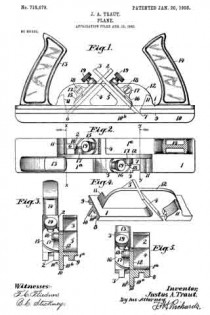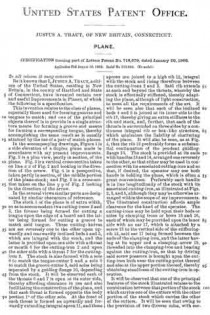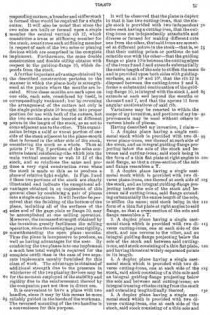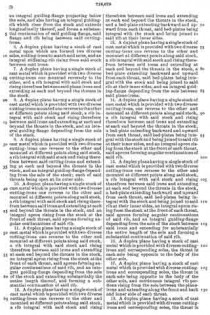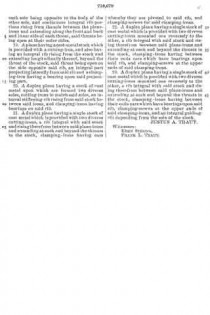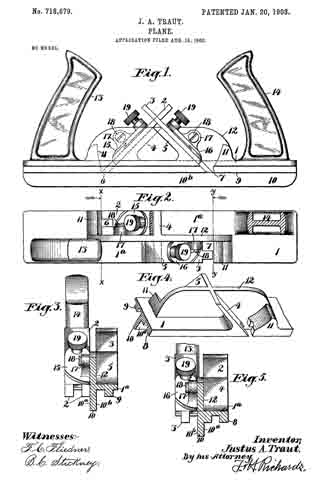
| PLEASE NOTE: The images presented on this page are of low resolution and, as a result, will not print out very well. If you wish to have higher resolution files then you may purchase them for only $2.95 per patent by using the "Buy Now" button below. All purchases are via PayPal. These files have all been cleaned up and digitally enhanced and are therefore suitable for printing, publication or framing. Each zip package contains all the images below (some packages may contain more), and purchased files can be downloaded immediately. |
UNITED STATES PATENT OFFICE.
_________________
JUSTUS A. TRAUT, OF NEW BRITAIN, CONNECTICUT.
PLANE.
_________________
SPECIFICATION forming part of Letters Patent No. 718,679, dated January 20, 1903.
Application filed August 16, 1902. Serial No. 119,845. (No model.)
_________________
To all whom it may concern:
Be it known that I, JUSTUS A. TRAUT, a citizen of the United States, residing in New Britain, in the county of Hartford and State of Connecticut, have invented certain new and useful Improvements in Planes, of which the following is a specification.
This invention relates to the class of planes, especially those used for forming grooves and tongues to match; and one of the principal objects thereof is to provide in a single structure means for forming a groove and means for forming a corresponding tongue, thereby accomplishing the same result as is usually attained by the use of a pair of match-planes.
In the accompanying drawings, Figure 1 is a side elevation of a duplex plane made in accordance with my present improvements. Fig. 2 is a plan view, partly in section, of the plane. Fig. 3 is a vertical cross-section taken on line x x of Fig. 2 and looking in the direction of the arrow. Fig. 4 is a perspective, taken partly in section, of the middle portion of the plane-stock; and Fig. 5 is a cross-section taken on the line y y of Fig. 2 looking in the direction of the arrow.
In the several views similar parts are designated by similar characters of reference.
The stock 1 of the plane is of extra width, so as to accomrnodate two cutting-irons 2 and 3, the former being formed for cutting a tongue upon the edge of a board and the latter being formed for cutting a groove to match said tongue. These cutting- knives are set reversely one to the other upon upwardly and rearwardly inclined beds 4 and 5, which are integral with the stock, and the latter is provided upon one side with a throat or mouth 6 for the cutting-iron 2 and upon the other side with a throat 7 for the cutting-iron 3. The stock is also formed with a sole 8 to match the tongue-cutter 2 and a sole 9 to match the groove-cutter 3, said soles being separated by a guiding-flange 10, depending from the stock. It will be observed each of the throats 6 and 7 is open at its outer side, thereby affording clearance in use and also facilitating the construction of the plane, and that each throat is formed opposite the body portion 1a of the other sole. At the front of each throat is formed an upwardly and forwardly extending integral apron 11, and these aprons are joined to a high rib 12, integral with the stock and rising therefrom between the cutting-irons 2 and 3. Said rib extends at each end beyond the throats, whereby the stock is effectually stiffened, thereby adapting the plane, although of light construction, to meet all the requirements of the art. It will be seen also that each of the inclined beds 4 and 5 is joined at its inner side to the rib 12, thereby giving an extra stiffness to the rib and stock, and, further, that each of the throats is surrounded on three sides by a continuous integral rib or box-like structure, which minimizes the liability of chattering of the plane. It will also be seen, as at Fig. 4, that the rib 12 preferably forms a substantial continuation of the pendent guiding-flange 10. The stock is provided at its ends with handles 13 and 14, arranged one reversely to the other, so that either may be used in connection with its associated cutting-iron and so that, if desired, the operator may use both hands in holding the plane, which is often a great convenience. Preferably each handle is in line longitudinally of the stock with its associated cutting-iron, as illustrated at Figs. 2, 3, and 5, although they may be otherwise arranged within the scope of my improvements. The illustrated construction affords ample clearance for the hand of the operator. The cutting-irons may be held upon their beds or sides by clamping irons or bows 15 and 16, each of which may be provided upon its inner side with an ear 17, which is attached by a screw 18 to the vertical side of the stiffening-rib 12, said ear 17 being formed between the ends of the clamping-iron, and the latter having at its upper end a clamping-screw 19, threaded into the clamping-iron and bearing against the cutting-iron, so that by driving said screw pressure is brought upon the cutting-iron both near the cutting-point thereof and also at the upper portion thereof, thereby obtaining steadiness ofthe cutting-iron in operation.
It will be observed that one of the principal features of the stock illustrated relates to the combination between that portion of the stock which carries one of the cutters with the other portion of the stock which carries the other of the cutters. It will be seen that owing to the provision of two diverse soles, with corresponding cutters, a broader and stiffer stock is formed than would be required for a single cutter. It will also be noted that since the two soles are built or formed upon a single member the central vertical rib 12, which constitutes a truss or stiffening member for the stock, constitutes such stiffening member in respect of each of the two soles or planing devices which are comprised in the complete implement. Furthermore, the same double construction and double utility obtains with respect to the guiding-flange 10, which depends from the stock.
A further important advantage obtained by the described construction pertains to the manner in which the plane-body is strengthened at the points where the mouths are located. Since these months are each open on one side, each sole, considered by itself, is correspondingly weakened; but by reversing the arrangement of the cutters not only is the single guide-plate 10 brought into proper position for use with both of the cutters, but the two mouths are also located at different points in the length of the stock, so as not to come adjacent one to the other. This organization brings a solid or uncut portion of one side of the stock adjacent to the plane-mouth that is formed in the other side of the stock, considering the stock as a whole. Thus at points 1a in Fig. 2 portions of the soles constitute lateral reinforcing-ribs which join the main vertical member or web 10 12 of the stock, and so reinforce the same and produce a very rigid construction even when the stock is made so thin as to produce a plane of relative light weight. In Figs. 3 and 5 these two portions of the stock are clearly illustrated and indicate the exceptional advantages obtained in an implement of this general class by combining a pair of planes into a single structure. It will further be perceived that the finishing of the bottom of the plane, including all of the surfaces of the soles and of the gage-plate or filange 10, may be accomplished at one milling operation. Moreover, the increased strength obtained by the invention greatly facilitates the milling operation, since the casting has great rigidity, notwithstanding the open plane-mouths. Thus the plane is inexpensive to produce, as well as having advantages for the user. By combining the two planes into one implement a much less total weight is required for the complete outfit than in the case of two separate implements usually furnished for this class of work. The advantage is obtained of additional strength due to the presence in whichever of the two planing devices may be for the moment employed of the stability and rigidity due to the reinforcement thereof by the companion part not then in direct use.
It is convenient to have a plane with two handles, since it may by this means be more reliably guided in the hands of the workman. The reversed mounting of the two handles is a convenience for this purpose.
It will be observed that the plane is duplex in that it has two cutting-irons, that the single stock is provided with two independent soles each having a cutting-iron, that the cutting-irons are independently attachable and diverse or formed for making different cuts one from the other, that said irons are mounted at different points in the stock — that is, so that their cutting points or portions do not coincide one with the other — that the guiding flange or plate 10 is between the cutting edges of the irons 2 and 3 and extends substantially the entire length of the sole to stiffen the same and is provided upon both sides with guiding-surfaces, as at 10a and 10b, that the rib 12 is disposed between the cutting-irons 2 and 3, forms a substantial continuation of the guiding-flange 10, is integral with the stock 1, and extends at each end beyond the months or throats 6 and 7, and that the aprons 11 form angular continuations of said rib.
Variations may be resorted to within the scope of my invention, and portions of my improvements may be used without others in various kinds of planes.
Having described my invention, I claim —
1. A duplex plane having a single cast-metal stock which is provided with two diverse plane-irons, one thereof at each side of the stock, and an integral guiding-flange projecting below the sole of the stock and between said cutting-irons; said stock being in the form of a thin flat plate at right angles to said flange, so that a cross-section of the sole and flange resembles a T.
2. A duplex plane having a single cast-metal stock which is provided with two diverse plane-irons, one thereof at each side of the stock, and an integral guiding-flange projecting below the sole of the stock and between said cutting-irons, said flange extend-ing substantially the entire length of the sole, to stiffen the same; said stock being in the forrn of a thin flat plate at right angles to said flange, so that a cross-section of the sole and flange resembles a T.
3. A duplex plane having a single cast-metal stock which is provided with two diverse cutting-irons, one at each side of the stock, and one reverse to the other, and an integral guiding-flange projecting below the sole of the stock and between said cutting-irons, said stock consisting of a thin fiat plate, and having throats at widely-separated points in its length.
4. A duplex plane having a single cast-metal stock which is provided with two diverse cutting-irons, one at each side of the stock, said stock consisting of a thin sole and an integral guiding-flange projecting below the sole and between said cutting-irons; an integral trussing-rib also rising from the stock and extending longitudinally thereof.
5. A duplex plane having a single cast-metal stock which is provided with two diverse cutting-irons, one at each side of the stock, said stock consisting of a thin sole and an integral guiding-flange projecting below the sole, and also having an integral guiding-rib which rises from the stock and extends longitudinally thereof, and forms a substantial continuation of said guiding-flange, said flange and rib being between said cutting-irons.
6. A duplex plane having a stock of cast metal upon which are formed two diverse soles, cutting-irons to match said soles, and an integral stiffening-rib rising from said stock between said irons.
7. A duplex plane having a single stock of cast metal which is provided with two diverse cutting-irons one mounted reversely to the other, and a rib integral with said stock and rising therefrom between said plane-irons and extending at each end beyond the throats in the stock.
8. A duplex plane having a single stock of cast metal which is provided with two diverse cutting-irons mounted one reverse to the other at different points along said stock, a rib integral with said stock and rising therefrom between said irons and extending at each end beyond the throats in the stock, and an integral guiding-flange depending from the sole of the stock.
9. A duplex plane having a single stock of cast metal which is provided with two diverse cutting-irons one reverse to the other and mounted at different points along said stock, a rib integral with said stock and rising therefrom between said cutting-irons and extending at each end beyond the throats in the stock, and an integral guiding-flange depending from the sole of the stock; each of said throats being open at its outer side.
10. A duplex plane having a single stock of cast metal which is provided with two diverse cutting-irons one reverse to the other and mounted at diderent points along said stock, a rib integral with said stock and rising therefrom between said irons and extending at each end beyond the throats in the stock, and an integral apron rising from the stock at the front of each throat, said aprons forming angular continuations of said rib.
11. A duplex plane having a single stock of cast metal which is provided with two diverse cutting-irons one reverse to the other and mounted at different points along said stock, a rib integral with said stock and rising therefrom between said irons and extending at each end beyond the throats in the stock, an integral apron rising from the stock at the front of each throat, said aprons forming angular continuations of said rib, and an integral guiding-flange depending from the sole of the stock and extending substantially the entire length thereof, and forming a substantial continuation of said rib.
12. A duplex plane having a single stock of cast metal which is provided with two diverse cutting-irons one reverse to the other and mounted at different points along said stock, a rib integral with said stock and rising therefrom between said irons and extending at each end beyond the throats in the stock, and a bed-plate extending backward and upward from each throat, said bed-plates being integral with the stock and being joined to said rib at their inner sides.
13. A duplex plane having a single stock of cast metal which is provided with two diverse cutting-irons one reverse to the other and mounted at different points along said stock, a rib integral with said stock and rising therefrom between said irons and extending at each end beyond the throats in the stock, a bed-plate extending backward and upward from each throat, said bed-plates being integral with the stock and being joined to said rib at their inner sides, and an integral guiding-flange depending from the sole between said plane-irons.
14. A duplex plane having a single stock of cast metal which is provided with two diverse cutting-irons, one reverse to the other and mounted at different points along said stock, a rib integral with said stock and rising therefrom between said irons and extending at each end beyond the throats in the stock, a bed-plate extending backward and upward from each throat, said bed-plates being integral with the stock and being joined to said rib at their inner sides, and an integral apron rising from the stock at the front of each throat, said aprons forming angular continuations of said rib.
15. A duplex plane having a single stock of cast metal which is provided with two diverse cutting-irons one reverse to the other and mounted at different points along said stock, a rib integral with said stock and rising therefrom between said irons and extending at each end beyond the throats in the stock, a bed-plate extending backward and upward from each throat, said bed-plates being integral with the stock and being joined to said rib at their inner sides, an integral apron rising from the stock at the front of each throat, said aprons forming angular continuations of said rib, and an integral guiding-flange depending from the sole of the stock between said irons and extending for substantially the entire length of the sole and forming a substantial continuation of said rib.
16. A duplex plane having a stock of cast metal which is provided with diverse cutting-irons and corresponding soles, the throat in each sole being opposite to the body of the other sole.
17. A duplex plane having a stock of cast metal which is provided with diverse cutting-irons and corresponding soles, the throat in each sole being opposite to the body of the other sole, and continuous integral rib portions rising from the sole between the plane-irons and extending along the front and back and inner side of each throat.
18. A duplex plane having a stock of cast metal which is provided with diverse cutting-irons and corresponding soles, the throat in each sole being opposite to the body of the other sole, and continuous integral rib portions rising from the sole between the plane-irons and extending along the front and back and inner side of each throat, said throats being open at their outer sides.
19. A plane having a cast-metal stock which is provided with a cutting-iron, and also having an integral rib rising from the stock and extending longitudinally thereof, beyond the throat of the stock, said throat being open on the side opposite said rib, an integral part projecting laterally from said rib and a clamping-iron having a bearing upon said projecting part.
20. A duplex plane having a stock of cast metal upon which are formed two diverse soles, cutting-irons to match said soles, an integral stiffening-rib rising from said stock between said irons, and clamping-irons having bearings on said rib.
21. A duplex plane having a single stock of cast metal which is provided with two diverse cutting-irons, a rib integral with said stock and rising therefrom between said plane-irons and extending at each end beyond the throats in the stock, clamping-irons having ears whereby they are pivoted to said rib, and clamping-screws for said clamping-irons.
22. A duplex plane having a single stock of cast metal which is provided with two diverse cutting-irons mounted one reversely to the other, a rib integral with said stock and rising therefrom between said plane-irons and extending at each end beyond the throats in the stock, clamping-irons having between their ends ears which have bearings upon said rib, and clamping-screws at the upper ends of said clamping-irons.
23. A duplex plane having a single stock of cast metal which is provided with two diverse cutting-irons mounted one reversely to the other, a rib integral with said stock and rising therefrom between said plane-irons and extending at each end beyond the throats in the stock, clamping-irons having between their ends ears which have hearings upon said rib, clamping-screws at the upper ends of said clamping-irons, and an integral guiding-rib depending from the sole of the stock.
JUSTUS A. TRAUT.
Witnesses:
EBEN STRONG,
FRANK L. TRAUT.

